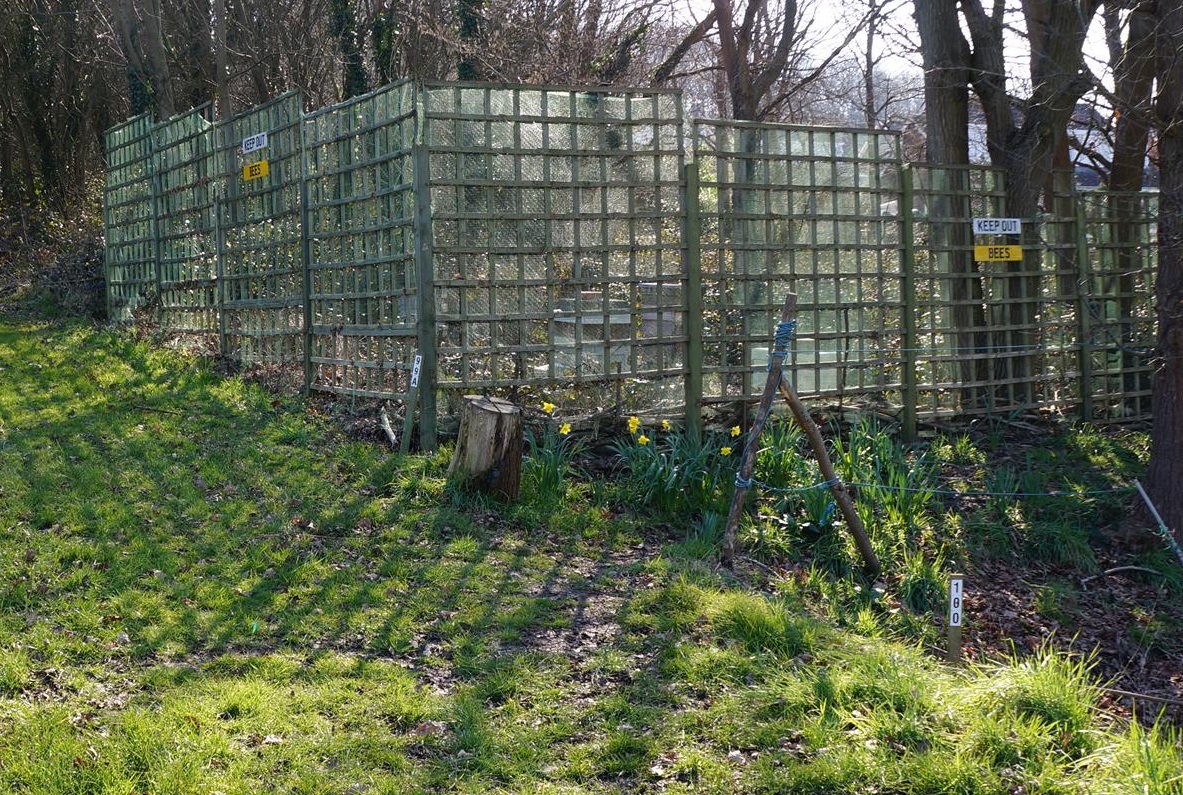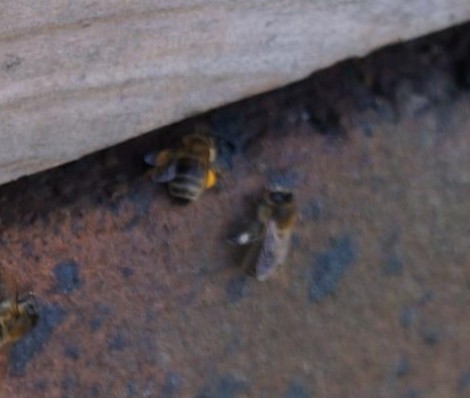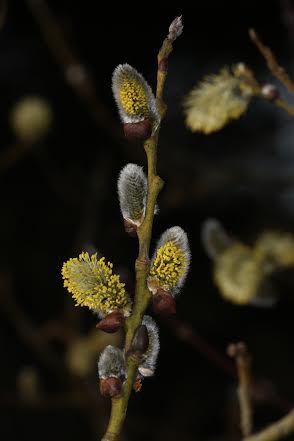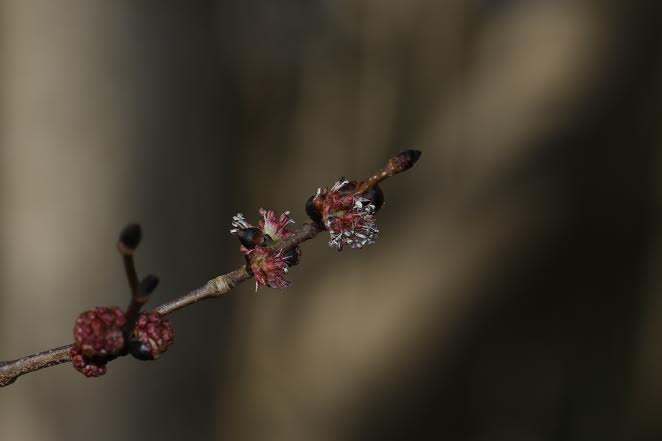 Abraham Lincoln
If given the truth, the people can be depended upon to meet any national crisis...
Abraham Lincoln
If given the truth, the people can be depended upon to meet any national crisis...
 Guildford news...
for Guildford people, brought to you by Guildford reporters - Guildford's own news service
Guildford news...
for Guildford people, brought to you by Guildford reporters - Guildford's own news service
Beekeeper’s Notes April 2016: No Pensions For Bees
Published on: 1 Apr, 2016
Updated on: 5 Apr, 2016
Hugh Coakley keeps bees in Worplesdon and talks about the new beekeeeping season and the bees working until they drop in his monthly series.
My bees, thank goodness, look to have got through the winter.
The two hives in my garden are very active, especially the polystyrene hive which stands in a sunny spot.

Busy hive entrance on a warm, sunny day in early March. Click on the photo to enlarge it. You can see pollen coming in on the bee’s back legs – a sign that the queen is likely to be laying.
Pollen has been coming in now on any days that the bees have been able to fly. That is a positive sign that the queen is doing her job and laying eggs for the next bee generation. Thank you queens.
On the allotment where I have three hives, it is quite shady and surrounded by active plots and gardens. So a different situation to the garden. Bees are woodland creatures so, even though it gets less sun, these cold- blooded creatures seem to do ok there.

Shady allotment apiary site but the bees like it. The screens encourage the bees to fly above head height when they leave the hive to go out foraging. They are less likely to annoy my lovely allotment neighbours than if they were buzzing along bumping into humans.
Two of my three hives look to be doing what they should be doing, active when the weather allows and bringing in plenty of pollen to feed the eggs that the queen is laying.
The fate of the third hive hangs in the balance. The queen is laying, but the numbers of bees in the colony is low after the winter. We shall see what happens.
It is a hard time for the bees who are reaching the end of their short lives now having survived the winter. Workers bees can live for months over the winter period but the older bees are dying off now.

Pollen coming into the hive. But one of the bees in the photo is dead. The bee carrying the yellow pollen got home but died before she could climb back in the hive.
The bee with the yellow pollen on her legs is dead. She had managed to get back to base but wasn’t quite able to get back into the hive. Bees work until they drop. No long life on a pension for bees.
The other bee next to her is carrying a grey-coloured pollen which could be maple or elm. The yellow-coloured pollen could be a number of plants including willow.
Not all colonies have survived the winter though.
My friend, who runs nine hives in various locations, has lost five of them. It is not clear why but it could be a combination of the bees running out of food at a crucial time or simply running out of a critical mass of bees as they die off over the winter.
Hard for the beekeeper but even harder for the bees.
Beekeeping is not all sad stories. It has its ups and downs. But I do get a thrill when I open up my hives for the first time in a season and get a first glimpse of a big, beautiful queen.
Another beekeeping year starts.
Dragon reader Harry Eve has sent these photos in and says:
“I have much appreciation for The Dragon and Hugh Coakley’s contributions.
“Determining the source of the pollen from its colour is particularly fascinating.
“Willow and Wych Elm have both been in flower in our borough over the last week or so. Here are a couple of photos taken at The Sheepleas.”
Responses to Beekeeper’s Notes April 2016: No Pensions For Bees
Leave a Comment Cancel replyPlease see our comments policy. All comments are moderated and may take time to appear.
Recent Articles
- Guildford Institute’s Crowdfunding Project for Accessible Toilet in its New Community and Wellbeing Centre
- Letter: Guildford – Another Opportunity Missed?
- Letter: GBC’s Corporate Strategy – Where Is the Ambition?
- My Memories of John Mayall at a Ground-breaking Gig in Guildford Nearly Six Decades Ago
- Westborough HMO Plans ‘Losing the Heart of the Street’ Says Resident
- College Invests to Boost Surrey’s Economy and Close Digital Skills Gap
- Community Lottery Brings Big Wins for Local Charities
- GBC Housing Plan Promises ‘A Vibrant Urban Neighbourhood’ Near Town Centre
- Hospital Pillows ‘Shortage’ at the Royal Surrey
- Updated: Caravans Set Up Camp at Ash Manor School


Recent Comments
- Ian Macpherson on Updated: Main Guildford to Godalming Road Closed Until August 1
- Sara Tokunaga on GBC Housing Plan Promises ‘A Vibrant Urban Neighbourhood’ Near Town Centre
- Michael Courtnage on Daily Mail Online Reports Guildford Has Highest-paid Council Officer
- Alan Judge on GBC Housing Plan Promises ‘A Vibrant Urban Neighbourhood’ Near Town Centre
- John Perkins on GBC Housing Plan Promises ‘A Vibrant Urban Neighbourhood’ Near Town Centre
- S Collins on GBC Housing Plan Promises ‘A Vibrant Urban Neighbourhood’ Near Town Centre
Search in Site
Media Gallery
Dragon Interview: Local Artist Leaves Her Mark At One of England’s Most Historic Buildings
January 21, 2023 / No Comment / Read MoreDragon Interview: Lib Dem Planning Chair: ‘Current Policy Doesn’t Work for Local People’
January 19, 2023 / No Comment / Read MoreA3 Tunnel in Guildford ‘Necessary’ for New Homes, Says Guildford’s MP
January 10, 2023 / No Comment / Read More‘Madness’ for London Road Scheme to Go Ahead Against ‘Huge Opposition’, Says SCC Leader
January 6, 2023 / No Comment / Read MoreCouncillor’s Son Starts Campaign for More Consultation on North Street Plan
December 30, 2022 / No Comment / Read MoreCounty Council Climbs Down Over London Road Works – Further ‘Engagement’ Period Announced
December 14, 2022 / No Comment / Read MoreDragon Interview: GBC Reaction to the Government’s Expected Decision to Relax Housing Targets
December 7, 2022 / No Comment / Read MoreHow Can Our Town Centre Businesses Recover? Watch the Shop Front Debate
May 18, 2020 / No Comment / Read More











Harry Eve
April 3, 2016 at 6:07 am
I think the willow is Salix caprea but am happy to be corrected. Elm flowers are much less spectacular than the seeds they produce later.
Mr Coakley’s fascinating article reminded me that, among the many non-social mining bees, there is one particular species that is very rare in Surrey and lives in the east of Guildford Borough. It collects from mainly one kind of wild flower and the pollen is salmon-pink in colour giving it a very distinctive appearance.